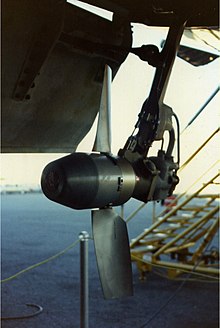Ram air turbine



The ram air turbine ( RAT , German ram pressure turbine ) is an emergency system for jet aircraft that generates hydraulic and / or electrical energy from the airstream.
Working method
In the event of a failure of all engines of a jet aircraft (including the auxiliary engine , if any), the hydraulic system is no longer supplied with pressure. In a conventionally (with the help of a hydraulic system) controlled aircraft, this means that controlled rudder movements are no longer possible. The aircraft is therefore no longer controllable.
In such a case, the RAT is automatically or manually unfolded from the underside of the fuselage or the wing. It consists of a propeller driven by the airstream, which drives a hydraulic pump or an electric generator. In this way, the hydraulic system can then be supplied with pressure or electrical power can be generated for the fly-by-wire systems. The pilot can thus approach an airport while gliding and make an emergency landing.
If, for example, all engines fail in the Airbus family, the hydraulic supply would continue to be ensured by electric pumps. Without engines, however, no power generator would be active any more, with the exception of the static inverter. This is a converter that converts the 28 V DC voltage of the batteries into 115 V / 400 Hz AC voltage and ensures the electrical supply exclusively from the battery for around 20 minutes. The RAT is therefore only automatically activated when the electrical busbars are de-energized. The propeller then operates a small hydraulic pump through the airstream , which in turn mainly drives the CSM / G (Constant Speed Motor / Generator). The CSM / G is a small hydraulic motor that drives a small generator. In the case of the A320, the output of this generator is 5 kVA. In comparison to the power of the engine generators with 90 kVA each, however, it is clear that in operation with a dynamic pressure turbine only the systems necessary for flight are supplied. Systems such as cabin lighting or the on-board kitchen are no longer supplied in such emergencies. Since the RAT is only an emergency system, it provides just enough energy to control the aircraft and keep the most important devices in operation.
Even the large hydraulic consumers such as landing flaps can not be supplied by the RAT's hydraulic pump . These systems must then be dispensed with in an emergency.As a rule, a separate actuation not to be driven by the RAT is provided for the chassis . For all commercial aircraft, the landing gear can be extended by its own weight ( English gravity drop ), in addition, the wind pushes the nose landing gear in its position.
Some aircraft manufacturers (such as: Boeing, McDonnell Douglas, Canadair ) which is RAT as ADG ( English air driven generator called). There, the ram-air turbine generates electricity using a built-in single-phase generator.
Depending on the aircraft model, the RAT is extended automatically or manually. On some aircraft, automatic triggering is carried out by a small pyrotechnic detonator (Canadair). A ram air turbine cannot be retracted again in flight on most aircraft.
Construction principle
There are three types of ram-air turbines:
- A first type primarily produces hydraulic pressure, which then feeds the hydraulic systems directly. With this variant, electricity can also be generated via a hydraulically operated generator. Example: Airbus.
- In a second type of RAT, an electric generator is driven, which primarily generates electrical energy and feeds it into the electrical system. Hydraulic pressure can then be generated here via an electric pump. Example: MD-11
- The third type is a hybrid configuration (electricity plus hydraulic pressure).
A ram-air turbine with just two blades takes up less space in the stowed position. So that it does not start rotating and causing damage while it is being extended, a blocking system does not release rotation until it is extended.
In the case of military aircraft, the RAT can also be used to provide additional power for special tasks if required.
Location
The RAT is installed near the main landing gear on Boeing aircraft models. With the smaller Airbus models, the RAT is installed in the belly fairing , in the belly, near the main landing gear, with the larger Airbus models in a wing pylon.
Incidents
Well-known incidents in which a ram air turbine was used were:
- 1983: Air Canada flight 143 : The emergency landing of a Boeing 767 from 12 km altitude after both engines failed due to lack of fuel.
- 1996: Ethiopian Airlines flight 961 : The crash of a hijacked Boeing 767 while attempting a ditching with only Ram Air turbine support.
- 2000: Hapag-Lloyd flight 3378 : Emergency landing of an Airbus A310 in Vienna after a lack of fuel caused by oneself.
- 2001: Air-Transat-Flight 236 : Emergency landing of an Airbus A330 due to lack of fuel after 120 km gliding flight in the Azores .
- 2009: US Airways flight 1549 : Ditching of an Airbus A320 after engine failure caused by a bird strike .
- 2020: Pakistan-International-Airlines 8303 : Crash of an Airbus A320-200 after a failed landing and the ensuing engine failure in Karachi.